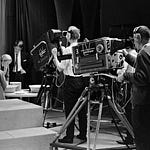The following was written a few years ago before studio sitcoms really fell out of favour, but I think there is still an appetite for them, especially in the mains. They are, however, really to get right.
Something else you’ll need to think about when you’re creating your sitcom is whether it’s going to be filmed in a studio in front of an audience (multi-cam) or shot entirely on location without an audience (single-cam). Which should your show be?
There’s a trite answer to this: If you want to gamble and be rich, make your show a multi-cam if you can. But if you want to be respected and win awards, go single-cam.
Between 2000 and 2015, only three multi-cam shows have won BAFTAs for Best Sitcom: Black Books, The IT Crowd and Mrs Brown’s Boys. In the last five years at the British Comedy Awards, the only multi-cam sitcoms to be even nominated have been Miranda, Count Arthur Strong and House of Fools. I have nothing against 2012, Rev, The Thick of It, Getting On, Peep Show, Moone Boy, Hunderby, Friday Night Dinner et al. But the statistics suggest that if you want to win awards, make sure your sitcom is single-cam.
One could argue that hardly any studio sitcoms are being made any more, hence the awards bias. That may be true, but there’s also a critic bias. Critics are invariably sneery and sniffy about multi-cam sitcoms and continue to be baffled and enraged by the very idea of a studio audience, and hearing their laughter.
There’s a possible reason for that: the sound of laughter cuts them out of the loop. It's hard to say ‘That’s simply not funny’ when there’s the sound of the audience falling about laughing, which is, I presume, why they often perpetuate the myth of ‘canned’/fake laughter. Only when a studio sitcom is deemed to be a runaway hit by the public will critics grudgingly accept it, as happened with Miranda which opened to very mixed reviews, but ended up being a ‘guilty pleasure’, which just means ‘pleasure’, surely?
Know Your Audience
The problem with being an aspiring writer or writer/performer is succumbing to the temptation of trying to write something that will impress your peers, win awards and get good critical reception. The safest way to do that is to write a non-audience, single-cam show. This has the added advantage that if it turns out to be not that funny, your show can be passed off as a comedy-drama, and much more about the characters, stories, and so on – which is, of course, hooey. But the fact is that you can’t pull this trick with a studio sitcom. There’s no safety net. No fall-back position. The lights are bright. The cast face the audience. When a multi-camera show doesn't really work, it hurts, and you can't pass if off as serious or experimental theatre.
The result of this is Comedy Commissioners’ desks are piled high with single-camera scripts. Do you want to spend months writing a script that is going to add to that vast pile, competing with the likes of Paul Whitehouse or Alan Davies for a half-hour slot on BBC2? You stand a much better chance of progressing with your script if you write something that can be filmed in a studio in front of an audience. Why?
TV Commissioners and Channel Controllers love audience shows because they know the audience aren’t an over-educated elite of snobs, but a mass of people who just like to laugh. And who don’t despise the sound of human laughter. Hence, they are always looking to commission multi-cam studio shows because they know the audiences at home like them.
Hopelessly Biased Advice
I am biased, obviously. I'm a studio audience guy. I started out writing revue sketches for the stage. I did Edinburgh Fringe shows every year from 1996 until 2002. I then did lots of radio recording in front of an audience. Virtually everything I've ever written or worked on has been recorded in front of an audience. Every single episode of Think The Unthinkable, Hut 33, Concrete Cow, Recorded for Training Purposes, Miranda, Another Case of Milton Jones/Thanks A Lot, Milton Jones, My Hero and My Family was recorded in front of an audience.
I’m always glad to write for a studio audience because you have to make them laugh. Out loud. So the microphones can pick up the noise. So you have to write jokes. Lots and lots of them. I'd aim for four per page, if not more. And if you're writing those jokes and getting those laughs, you're most of the way there.
This is hard work. Incredibly hard work. Once you've plotted, outlined, written and rewritten your script, you have to go through it again and again, being absolutely brutal about every single line, beat and comma. Every line has to be in character, and if it's not moving the story along it has to be a set-up to a joke, or a joke (again, all in character) so you get that regular laugh. Listen to how often the audience laugh on an episode of Friends. It's terrifyingly metronomic. But that's what you're aiming for. And the prospect of 250 or more total strangers filing in to watch your show on a cold November evening gets your mind working and your fingers tapping your keyboard.
A single-camera show bypasses this. You don't have that terror driving you on to put jokes all over the place. The millions watching at home are miles and months away. After a shoot and an edit. That's why I'm always so impressed by genuinely hilarious non-audience shows (like Peep Show, The Inbetweeners and The Thick of It in the UK and Arrested Development, Modern Family, 30 Rock and Parks and Rec in the US). They managed to make their shows so funny without that discipline of a studio audience. That takes slavish commitment.
Conversely, I'm rarely surprised when a single-camera show isn't very funny at all. And I don’t mean that to be dismissive or mean-spirited. It’s a question of where the different formats come from. I’d like to divert into an area that I think many of us haven't really considered - which is how single camera and studio sitcoms come from such different places.
Acceptable Contrivances
Studio sitcoms are contrived. They are mostly indoors with the same characters every week. Stories tend to take place within a 48-72 hours time frame. There are set-pieces, sometimes verging on pantomime - and the studio audience and often the viewers at home are fine with it. The audience is normally happy to accept all the contrivances. These sorts of shows, though, are more like provincial or farce theatre than most other forms of television or media. Doors open and close. People come and go. Things are said and misconstrued until eventually there is a denouement where all is revealed.
Single camera sitcoms, though, are filmed in a completely different way and have a totally different feel to them. They're more like movies than studio sitcoms. They have a different pace – mainly because of audience expectation. Sometimes single- camera shows have a fresh style or idea, like The Office’s docudrama feel, Peep Show's point-of-view shooting, The Thick of It's shaky camera (which was very original when they started doing it). Other shows feel like they should be out and about, like Rev, which works well as it is, and nicely avoids any kind of comparison to The Vicar of Dibley, which casts a large shadow over any kind of subsequent ecclesiastical comedy.
And then there are other shows from the last few years that are undoubtedly classified as comedies, but would shy away from the term 'sitcom' because they don't feel very ‘sitcommy’. Yet they’re not very ‘out and about either’. Shows like Him and Her or Roger and Val Have Just Got In – and before that The Royle Family and The Smoking Room - are half-hour narrative comedies. They don't need to be single-camera because they are totally confined shows that could be shot easily on TV studio sets in front of an audience, but they have their own pace which is, ironically, more akin to Pinter or Beckett than Brian Rix. In fact, Him and Her would actually work well in front of a particular studio audience but probably not the type who applied for tickets to Mrs Brown’s Boys and got something else instead. An awful lot of comedy is about expectation.
Diversion Over
The point is that the comedy spectrum has never been wider. In the 1950s, you played your comedy theatre-style to an audience. You can still do it, or you can go on location and film the whole thing in ‘Afghanistan’ (The Western Cape of South Africa in the case of Bluestone 42). Or you could do something that could play in a studio, but not in a traditional sense. It’s up to you, but it’s worth having a sense of this before you start writing your show – even if you end up changing it once it develops. But previous advice still stands. Think Big.
Big characters work well in a studio. Big worlds work well on location. Big ideas, ideas that matter and last, can work anywhere. It’s up to you – partly – to work out where.
Next time, I’ll be advising you not to write what you know.
If you can’t wait, you can get the whole book, Writing That Sitcom, as a PDF right now here. Or the audio version here.
Thinking Big
Listen now (5 min) | We need to think about characters, but before we get there, let’s think big. It’s very tempting to tone down your writing because you know it’s television, which has limited budgets, especially in the UK. There seems to be plenty of money around to make ‘quality drama’ or period whodunnits about Oxford dons being poisoned by a member of the Biology facul…














Share this post